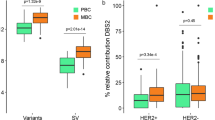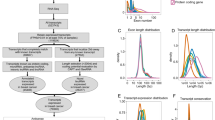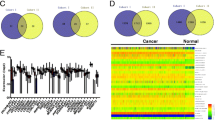Abstract
Breast cancer is a major health problem affecting millions of women worldwide. Over 200,000 new cases are diagnosed annually in the USA, with approximately 40,000 of these cases resulting in death. HER2-positive (HER2+) breast tumors, representing 20–30 % of early-stage breast cancer diagnoses, are characterized by the amplification of the HER2 gene. However, the critical genes and pathways that become affected by HER2 amplification in humans are yet to be specifically identified. Furthermore, it is yet to be determined if HER2 amplification also affects the expression of long intervening non-coding (linc)RNAs, which are involved in the epigenetic regulation of gene expression. We examined changes in gene expression by next generation RNA sequencing in human tumors pre- and post- HER2 inhibition by trastuzumab in vivo, and changes in gene expression in response to HER2 knock down in cell culture models. We integrated our results with gene expression analysis of HER2+ tumors vs matched normal tissue from The Cancer Genome Atlas. The integrative analyses of these datasets led to the identification of a small set of mRNAs, and the associated biological pathways that become deregulated by HER2 amplification. Furthermore, our analyses identified three lincRNAs that become deregulated in response to HER2 amplification both in vitro and in vivo. Our results should provide the foundation for functional studies of these candidate mRNAs and lincRNAs to further our understanding of how HER2 amplification results in tumorigenesis. Also, the identified lincRNAs could potentially open the door for future RNA-based biomarkers and therapeutics in HER2+ breast cancer.







Similar content being viewed by others
References
Siegel R, Naishadham D, Jemal A (2012) Cancer statistics, 2012. CA Cancer J Clin 62(1):10–29
Cancer Genome Atlas Network (2012) Comprehensive molecular portraits of human breast tumours. Nature 490(7418):61–70
Mitri Z, Constantine T, O’Regan R (2012) The HER2 receptor in breast cancer: pathophysiology, clinical use, and new advances in therapy. Chemother Res Pract 2012:743193
Cabili MN, Trapnell C, Goff L, Koziol M, Tazon-Vega B, Regev A, Rinn JL (2011) Integrative annotation of human large intergenic noncoding RNAs reveals global properties and specific subclasses. Genes Dev 25(18):1915–1927
Khalil AM, Guttman M, Huarte M, Garber M, Raj A, Rivea Morales D, Thomas K, Presser A, Bernstein BE, van Oudenaarden A et al (2009) Many human large intergenic noncoding RNAs associate with chromatin-modifying complexes and affect gene expression. Proc Natl Acad Sci USA 106(28):11667–11672
Guttman M, Amit I, Garber M, French C, Lin MF, Feldser D, Huarte M, Zuk O, Carey BW, Cassady JP et al (2009) Chromatin signature reveals over a thousand highly conserved large non-coding RNAs in mammals. Nature 458(7235):223–227
Sauvageau M, Goff LA, Lodato S, Bonev B, Groff AF, Gerhardinger C, Sanchez-Gomez DB, Hacisuleyman E, Li E, Spence M et al (2013) Multiple knockout mouse models reveal lincRNAs are required for life and brain development. eLife 2(0):e01749
Fatica A, Bozzoni I (2014) Long non-coding RNAs: new players in cell differentiation and development. Nat Rev Genet 15(1):7–21
Grote P, Wittler L, Hendrix D, Koch F, Wahrisch S, Beisaw A, Macura K, Blass G, Kellis M, Werber M et al (2013) The tissue-specific lncRNA Fendrr is an essential regulator of heart and body wall development in the mouse. Dev Cell 24(2):206–214
Kretz M, Webster DE, Flockhart RJ, Lee CS, Zehnder A, Lopez-Pajares V, Qu K, Zheng GX, Chow J, Kim GE et al (2012) Suppression of progenitor differentiation requires the long noncoding RNA ANCR. Genes Dev 26:338–343
Guttman M, Donaghey J, Carey BW, Garber M, Grenier JK, Munson G, Young G, Lucas AB, Ach R, Bruhn L et al (2011) lincRNAs act in the circuitry controlling pluripotency and differentiation. Nature 477(7364):295–300
Loewer S, Cabili MN, Guttman M, Loh YH, Thomas K, Park IH, Garber M, Curran M, Onder T, Agarwal S et al (2010) Large intergenic non-coding RNA-RoR modulates reprogramming of human induced pluripotent stem cells. Nat Genet 42(12):1113–1117
Huarte M, Guttman M, Feldser D, Garber M, Koziol MJ, Kenzelmann-Broz D, Khalil AM, Zuk O, Amit I, Rabani M et al (2010) A large intergenic noncoding RNA induced by p53 mediates global gene repression in the p53 response. Cell 142(3):409–419
Gupta RA, Shah N, Wang KC, Kim J, Horlings HM, Wong DJ, Tsai MC, Hung T, Argani P, Rinn JL et al (2010) Long non-coding RNA HOTAIR reprograms chromatin state to promote cancer metastasis. Nature 464(7291):1071–1076
Moran VA, Perera RJ, Khalil AM (2012) Emerging functional and mechanistic paradigms of mammalian long non-coding RNAs. Nucleic Acids Res 40:6391–6400
Wang KC, Chang HY (2011) Molecular mechanisms of long noncoding RNAs. Mol Cell 43(6):904–914
Clark MB, Mattick JS (2011) Long noncoding RNAs in cell biology. Semin Cell Dev Biol 22(4):366–376
Qureshi IA, Mattick JS, Mehler MF (2010) Long non-coding RNAs in nervous system function and disease. Brain Res 1338:20–35
Carrieri C, Cimatti L, Biagioli M, Beugnet A, Zucchelli S, Fedele S, Pesce E, Ferrer I, Collavin L, Santoro C et al (2012) Long non-coding antisense RNA controls Uchl1 translation through an embedded SINEB2 repeat. Nature 491(7424):454–457
Yildirim E, Kirby JE, Brown DE, Mercier FE, Sadreyev RI, Scadden DT, Lee JT (2013) Xist RNA is a potent suppressor of hematologic cancer in mice. Cell 152(4):727–742
Wang KC, Yang YW, Liu B, Sanyal A, Corces-Zimmerman R, Chen Y, Lajoie BR, Protacio A, Flynn RA, Gupta RA et al (2011) A long noncoding RNA maintains active chromatin to coordinate homeotic gene expression. Nature 472(7341):120–124
Ulitsky I, Shkumatava A, Jan CH, Sive H, Bartel DP (2011) Conserved function of lincRNAs in vertebrate embryonic development despite rapid sequence evolution. Cell 147(7):1537–1550
Tsai MC, Manor O, Wan Y, Mosammaparast N, Wang JK, Lan F, Shi Y, Segal E, Chang HY (2010) Long noncoding RNA as modular scaffold of histone modification complexes. Science 329(5992):689–693
Cesana M, Cacchiarelli D, Legnini I, Santini T, Sthandier O, Chinappi M, Tramontano A, Bozzoni I (2011) A long noncoding RNA controls muscle differentiation by functioning as a competing endogenous RNA. Cell 147(2):358–369
Niland CN, Merry CR, Khalil AM (2012) Emerging roles for long non-coding RNAs in cancer and neurological disorders. Front Genet 3:25
Taft RJ, Pang KC, Mercer TR, Dinger M, Mattick JS (2010) Non-coding RNAs: regulators of disease. J Pathol 220(2):126–139
Mattick JS (2009) The genetic signatures of noncoding RNAs. PLoS Genet 5(4):e1000459
Iyer MK, Niknafs YS, Malik R, Singhal U, Sahu A, Hosono Y, Barrette TR, Prensner JR, Evans JR, Zhao S et al (2015) The landscape of long noncoding RNAs in the human transcriptome. Nat Genet
Morris KV, Mattick JS (2014) The rise of regulatory RNA. Nat Rev Genet 15(6):423–437
Yang Z, Zhou L, Wu LM, Lai MC, Xie HY, Zhang F, Zheng SS (2011) Overexpression of long non-coding RNA HOTAIR predicts tumor recurrence in hepatocellular carcinoma patients following liver transplantation. Ann Surg Oncol 18(5):1243–1250
Kogo R, Shimamura T, Mimori K, Kawahara K, Imoto S, Sudo T, Tanaka F, Shibata K, Suzuki A, Komune S et al (2011) Long noncoding RNA HOTAIR regulates polycomb-dependent chromatin modification and is associated with poor prognosis in colorectal cancers. Cancer Res 71(20):6320–6326
Sendur MA, Aksoy S, Ozdemir NY, Zengin N, Altundag K (2012) What is the mechanism of progression with trastuzumab treatment—escape or resistance? Asian Pacific J Cancer Prevent APJCP 13(11):5929–5930
Le XF, Lammayot A, Gold D, Lu Y, Mao W, Chang T, Patel A, Mills GB, Bast RC Jr (2005) Genes affecting the cell cycle, growth, maintenance, and drug sensitivity are preferentially regulated by anti-HER2 antibody through phosphatidylinositol 3-kinase-AKT signaling. J Biol Chem 280(3):2092–2104
Cancer Genome Atlas Research N, Weinstein JN, Collisson EA, Mills GB, Shaw KR, Ozenberger BA, Ellrott K, Shmulevich I, Sander C, Stuart JM (2013) The cancer genome atlas pan-cancer analysis project. Nat Genet 45(10):1113–1120
Wang Z, Gerstein M, Snyder M (2009) RNA-Seq: a revolutionary tool for transcriptomics. Nat Rev Genet 10(1):57–63
Ulitsky I, Bartel DP (2013) lincRNAs: genomics, evolution, and mechanisms. Cell 154(1):26–46
Moran VA, Perera RJ, Khalil AM (2012) Emerging functional and mechanistic paradigms of mammalian long non-coding RNAs. Nucleic Acids Res 40(14):6391–6400
Putluri N, Maity S, Kommagani R, Creighton CJ, Putluri V, Chen F, Nanda S, Bhowmik SK, Terunuma A, Dorsey T et al (2014) Pathway-centric integrative analysis identifies RRM2 as a prognostic marker in breast cancer associated with poor survival and tamoxifen resistance. Neoplasia 16(5):390–402
Kaneko S, Bonasio R, Saldana-Meyer R, Yoshida T, Son J, Nishino K, Umezawa A, Reinberg D (2014) Interactions between JARID2 and noncoding RNAs regulate PRC2 recruitment to chromatin. Mol Cell 53(2):290–300
Moskalev EA, Schubert M, Hoheisel JD (2012) RNA-directed epigenomic reprogramming: an emerging principle of a more targeted cancer therapy? Genes Chromosomes Cancer 51(2):105–110
Jiang J, Jing Y, Cost GJ, Chiang JC, Kolpa HJ, Cotton AM, Carone DM, Carone BR, Shivak DA, Guschin DY et al (2013) Translating dosage compensation to trisomy 21. Nature 500(7462):296–300
Khalil AM, Rinn JL (2011) RNA-protein interactions in human health and disease. Semin Cell Dev Biol 22(4):359–365
Mustafi D, Kevany BM, Bai X, Maeda T, Sears JE, Khalil AM, Palczewski K (2013) Evolutionarily conserved long intergenic non-coding RNAs in the eye. Hum Mol Genet 22:2992–3002
Geisler S, Coller J (2013) RNA in unexpected places: long non-coding RNA functions in diverse cellular contexts. Nat Rev Mol Cell Biol 14(11):699–712
Wapinski O, Chang HY (2011) Long noncoding RNAs and human disease. Trends Cell Biol 21(6):354–361
Dinger ME, Pang KC, Mercer TR, Crowe ML, Grimmond SM, Mattick JS (2009) NRED: a database of long noncoding RNA expression. Nucleic Acids Res 37(Database issue):D122–D126
Livak KJ, Schmittgen TD (2001) Analysis of relative gene expression data using real-time quantitative PCR and the 2(−delta delta C(T)) Method. Methods 25(4):402–408
Trapnell C, Roberts A, Goff L, Pertea G, Kim D, Kelley DR, Pimentel H, Salzberg SL, Rinn JL, Pachter L (2012) Differential gene and transcript expression analysis of RNA-seq experiments with TopHat and Cufflinks. Nat Protoc 7(3):562–578
Acknowledgments
We would like to thank Maria Sandoval, Jennifer Yori, and Ruth Keri at CWRU Pharmacology for BT474 cells and other reagents; Vinay Varadan at Case Comprehensive Cancer Center and Sheldon Bai at the RNA Center for discussion of bioinformatic analyses; Megan E Forrest, Jessica Sabers, Thomas LaFramboise, and Anthony Wynshaw-Boris for discussion of results.
Conflict of interest
Callie R. Merry, Sarah McMahon, Cheryl L. Thompson, Kristy L.S. Miskimen, Lyndsay Harris, and Ahmad M Khalil declare that there is no conflict of interest to be disclosed.
Author information
Authors and Affiliations
Corresponding author
Electronic supplementary material
Below is the link to the electronic supplementary material.
10549_2015_3327_MOESM1_ESM.xlsx
Supplementary material 1 (XLSX 10 kb). Supporting file 1. Information regarding clinical trial with trastuzumab in all 13 patients with indication of patients that achieved pathological complete response (pCR) at the end of the trial
10549_2015_3327_MOESM2_ESM.xlsx
Supplementary material 2 (XLSX 11812 kb). Supporting file 2. Differentially expressed mRNAs by RNA-seq in 11 HER2+ breast cancer patients pre- vs post- one dose of trastuzumab. These patients achieved pathological complete response (pCR) at the end of the clinical trial
10549_2015_3327_MOESM3_ESM.xlsx
Supplementary material 3 (XLSX 1961 kb). Supporting file 3. Differentially expressed lincRNAs by RNA-seq in 11 HER2+ breast cancer patients pre- vs post- one dose of trastuzumab. These patients achieved pathological complete response (pCR) at the end of the clinical trial
10549_2015_3327_MOESM4_ESM.xlsx
Supplementary material 4 (XLSX 52 kb). Supporting file 4. Differentially expressed mRNAs by RNA-seq analysis in BT474 cells treated with either negative control (NC) or HER2 siRNAs. Gene expression is calculated as FPKM values
10549_2015_3327_MOESM5_ESM.xlsx
Supplementary material 5 (XLSX 43 kb). Supporting file 5. Differentially expressed lincRNAs by RNA-seq analysis in BT474 cells treated with either negative control (NC) or HER2 siRNAs. Gene expression is calculated as FPKM values
10549_2015_3327_MOESM6_ESM.xlsx
Supplementary material 6 (XLSX 31 kb). Supporting file 6. Pathway analysis of differentially expressed mRNAs (RNA-seq) in BT474 cells treated with either negative control or HER2 siRNAs
10549_2015_3327_MOESM7_ESM.xlsx
Supplementary material 7 (XLSX 7136 kb). Supporting file 7. Differentially expressed mRNAs that are in common between affected mRNAs in response to trastuzumab inhibition of HER2 in clinical trial patients and affected mRNAs due to HER2 depletion in BT474 via siRNAs
10549_2015_3327_MOESM8_ESM.xlsx
Supplementary material 8 (XLSX 1286 kb). Supporting file 8. Differentially expressed lincRNAs that are in common between affected lincRNAs in response to trastuzumab inhibition of HER2 in clinical trial patients and affected lincRNAs due to HER2 depletion in BT474 via siRNAs
10549_2015_3327_MOESM9_ESM.xlsx
Supplementary material 9 (XLSX 4086 kb). Supporting file 9. Information related to HER2+ breast cancer patients from the TCGA cohort that we utilized for gene expression analysis
10549_2015_3327_MOESM10_ESM.xlsx
Supplementary material 10 (XLSX 652 kb). Supporting file 10. Differentially expressed mRNAs (RNA-seq) in HER2+ tumors vs matched normal breast tissue in TCGA cohort. Expression values are calculated as FPKM values
10549_2015_3327_MOESM11_ESM.pdf
Supplementary material 11 (PDF 137 kb). Supporting file 11. Differentially expressed lincRNAs (RNA-seq) in HER2+ tumors vs matched normal breast tissue in TCGA cohort. Expression values are calculated as FPKM values
10549_2015_3327_MOESM12_ESM.xlsx
Supplementary material 12 (XLSX 122 kb). Supporting file 12. Expression values and associated graph of the 35 mRNAs that we identified in all three data sets as responsive to HER2 expression levels
10549_2015_3327_MOESM13_ESM.xlsx
Supplementary material 13 (XLSX 57 kb). Supporting file 13. A complete list of all qPCR primers used in the current study
Rights and permissions
About this article
Cite this article
Merry, C.R., McMahon, S., Thompson, C.L. et al. Integrative transcriptome-wide analyses reveal critical HER2-regulated mRNAs and lincRNAs in HER2+ breast cancer. Breast Cancer Res Treat 150, 321–334 (2015). https://doi.org/10.1007/s10549-015-3327-1
Received:
Accepted:
Published:
Issue Date:
DOI: https://doi.org/10.1007/s10549-015-3327-1




